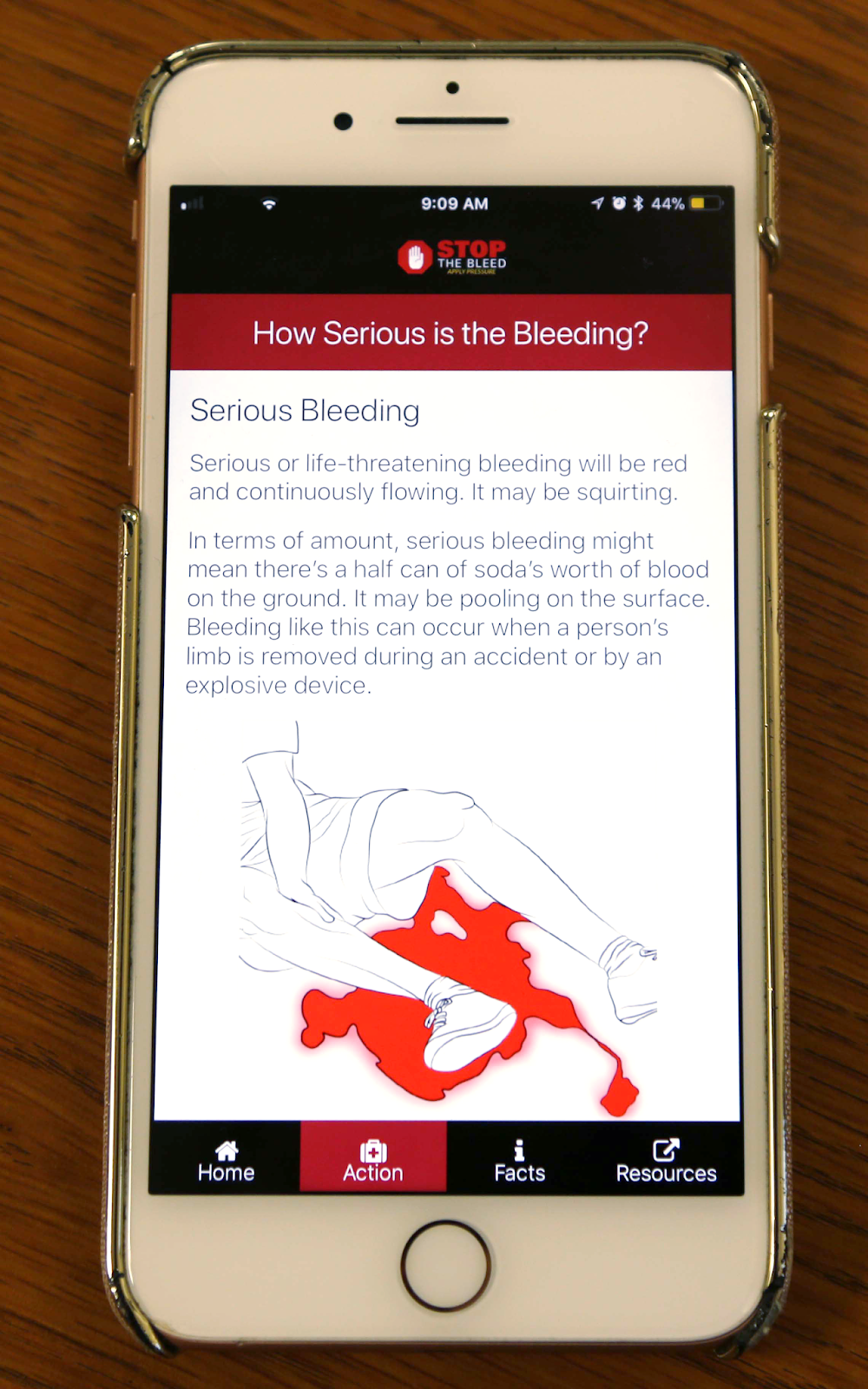New App Teaches Citizens to ‘Stop the Bleed,’ Save a Life
Free app available for download in the Apple App Store and Google Play.
By Sarah Marshall
Knowing what to do to save a life in the aftermath of a mass trauma event -- natural disaster, vehicle accident, or violent attack – is now right at the touch of a button. Uniformed Services University’s (USU) National Center for Disaster Medicine and Public Health (NCDMPH) recently launched “Stop the Bleed,” a free iPhone and Android app designed to teach users how to stop life-threatening bleeding in an emergency – and hopefully save lives.
 “We are extremely proud to make the app available to the public,” said Dr. Thomas Kirsch, director of NCDMPH. “It’s an important step in the ‘Stop the Bleed’ initiative, which is an effort to teach citizens how to save lives from major trauma the same way bystanders would administer CPR to someone in cardiac arrest.”
“We are extremely proud to make the app available to the public,” said Dr. Thomas Kirsch, director of NCDMPH. “It’s an important step in the ‘Stop the Bleed’ initiative, which is an effort to teach citizens how to save lives from major trauma the same way bystanders would administer CPR to someone in cardiac arrest.”“Stop the Bleed” is a White House-launched effort between several Federal and civilian agencies, including USU. The initiative launched in 2015 to teach citizens how to save lives from major trauma the same way bystanders would administer CPR to someone in cardiac arrest. But it’s not like other public education campaigns – it’s based on important lessons learned on the battlefield and a decade of research by the U.S. military. Researchers found that equipping troops with individual first aid kits that contain tourniquets and hemostatic dressings to control severe blood loss, combined with training on hemorrhage control for medical and non-medical forces alike, paid off. Thousands of lives have been saved on the battlefield.
“Our hope is that the ‘Stop the Bleed’ app empowers individuals to take action in the crucial minutes before first responders arrive,” said Dr. Craig Goolsby, science director at NCDMPH. “The ‘Stop the Bleed’ app provides instant access to instruction on differentiating life-threatening bleeding from non-life threatening bleeding, and how to apply tourniquets to stop bleeding.”
“Severe bleeding can lead to death in less than 5 minutes”
 As part of this initiative, Goolsby’s team of researchers also published three studies looking at the lay person’s ability to apply tourniquets, measuring which tactics are most effective for teaching the public how to apply these techniques. They have also recently received a grant to develop a layperson tourniquet. Through their research thus far, USU researchers have also discovered that an untrained person could effectively apply a tourniquet just by learning on the spot – what they refer to as “just in time” training. Based on these findings, the lay person would know what to do to “stop the bleed” about 50 percent of the time with “just in time” training, however, if they have just 15 minutes of web-based training, combined with “just in time” training, this jumps to a success rate of 75 percent. They also found that those who had web-based training were not only willing, but also able to use the tourniquets quickly, and could also tell which wounds required tourniquets.
As part of this initiative, Goolsby’s team of researchers also published three studies looking at the lay person’s ability to apply tourniquets, measuring which tactics are most effective for teaching the public how to apply these techniques. They have also recently received a grant to develop a layperson tourniquet. Through their research thus far, USU researchers have also discovered that an untrained person could effectively apply a tourniquet just by learning on the spot – what they refer to as “just in time” training. Based on these findings, the lay person would know what to do to “stop the bleed” about 50 percent of the time with “just in time” training, however, if they have just 15 minutes of web-based training, combined with “just in time” training, this jumps to a success rate of 75 percent. They also found that those who had web-based training were not only willing, but also able to use the tourniquets quickly, and could also tell which wounds required tourniquets.Goolsby and his colleagues, including staff from NCDMPH and Department of Military and Emergency Medicine, in collaboration with the University of Virginia and Charlottesville, Va., have also been working on a study as part of this initiative. They hope to determine which types of dressings would be easiest for the layperson to use, to control blood loss.
Additionally, last year, Goolsby developed a Stop the Bleed Education Consortium (SBEC). This informal group of medical educators, public health professionals, and clinicians with expertise in hemorrhage control, has been working to define what it means to be “Stop the Bleed” trained, since this previously was had not been defined through the course of this initiative. The group has also been reviewing existing “Stop the Bleed” training programs, and implementing ways to ensure their efficacy.
“We want people to understand how to provide lifesaving support, but we also want people to have access to the most effective lifesaving support kits, and we want them to know the phrase, ‘Stop the Bleed,’” Goolsby said.
Download the app on your mobile device or tablet in the Apple App Store or Google Play Store.
Follow NCDMPH








